
Giovanni di Pietro di Bernardone, known as Francis of Assisi, was an Italian mystic, poet, and Catholic friar who founded the religious order of the Franciscans. Inspired to lead a Christian life of poverty, he became a beggar and itinerant preacher.

Assisi is a town and commune of Italy in the Province of Perugia in the Umbria region, on the western flank of Monte Subasio.

Anthony of Padua, OFM, or Anthony of Lisbon was a Portuguese Catholic priest and member of the Order of Friars Minor.
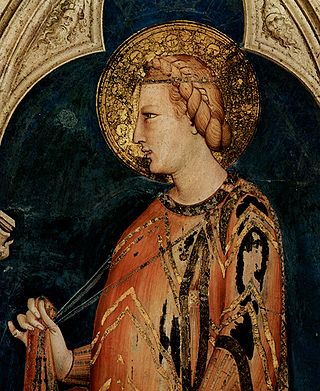
Elizabeth of Hungary, also known as Elisabeth of Thuringia, was a princess of the Kingdom of Hungary and the landgravine of Thuringia.

Giles of Assisi, was one of the original companions of Francis of Assisi and holds a leading place among them. St. Francis called him "The Knight of our Round Table".

Portiuncula, also spelled Porziuncola or Porzioncula, is a small Catholic church located within the Papal Basilica of Saint Mary of the Angels in Assisi in the frazione of Santa Maria degli Angeli, situated about 4 kilometres (2.5 mi) from Assisi, Umbria. It is the place from where the Franciscan movement started.

Conrad of Parzham, O.F.M. Cap., was a German Capuchin lay brother. He served for over 40 years in the post of porter of the Capuchin friary in Altötting, through which work he gained a widespread reputation for his wisdom and holiness. He has been canonized by the Catholic Church.

Crispino da Viterbo - born Pietro Fioretti - was an Italian Roman Catholic professed religious from Order of Friars Minor Capuchin. Fioretti was an ardent devotee of the Mother of God and was consecrated to her protection in 1674 and he even made a small altar dedicated to her when he served in the kitchens at the house in Orvieto. He served in various roles for the order in various cities around Rome where he became a well-known figure with various nobles and prelates - even Pope Clement XI visiting him and seeking him out for advice and support. Fioretti likewise was known as a sort of wonderworker who worked miracles during his lifetime. He was also known for his warm sense of humor and his simple method for living.

Szymon of Lipnica was a Polish catholic priest and a professed member from the Order of Friars Minor. He became a sought after and noted preacher and took as his preaching inspiration Saint Bernardine of Siena and also was a strong proponent of popular devotions that he worked to spread.
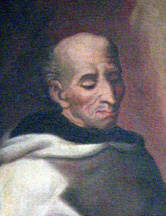
Angelo Paoli, O.Carm – born Francesco – was an Italian Catholic priest and a professed member from the Carmelites. Paoli became known as the "father of the poor" due to his strong charitable outreach, for which he received praise from a number of cardinals and other prelates while living in Rome. This extended to his friend Cardinal Giuseppe Maria Tomasi and to Popes Innocent XII and Clement XI, who both offered him the cardinalate, which he refused.

Chiara Offreduccio, known as Clare of Assisi, is an Italian saint who was one of the first followers of Francis of Assisi.
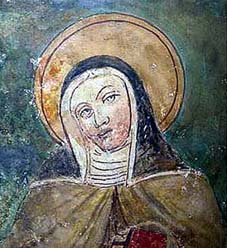
Philippa Mareri was born in 1190/1200 and died in 1236. Beatified in 1247, her sanctuary is in Borgo San Pietro, a frazione of Petrella Salto. Her feast day is 16 February. She was the foundress of the monastery of Franciscan Sisters of Saint Philippa Mareri or Poor Clares.
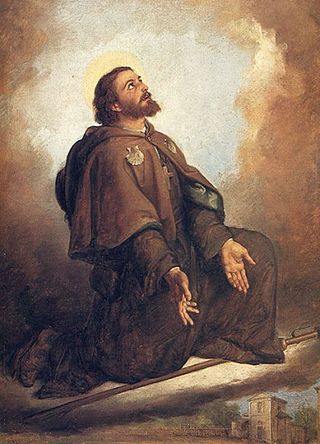
Amato Ronconi was an Italian Catholic who became a professed member of the Secular Franciscan Order. Ronconi lived a life of penitence and dedicated all his works to the poor through the construction of chapels and hospitals – one such hospital still exists in his home of Rimini. The residents in this town recognised his good deeds and hailed Ronconi as a saint in his own lifetime.
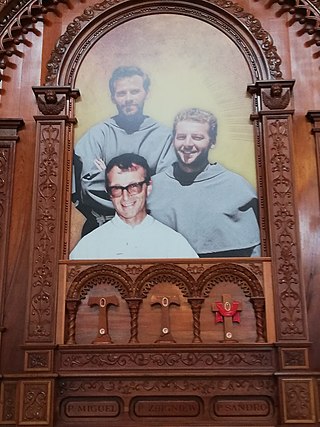
The Three Martyrs of Chimbote were a group of two Polish Franciscan priests and one Italian missionary priest murdered in Peru in 1991 by the Shining Path communist guerillas. Michał Tomaszek and Zbigniew Adam Strzałkowski, and Alessandro Dordi were murdered on 9 August and 25 August 1991 respectively.
Teresa Manganiello was an Italian who became a member of the Secular Franciscan Order. She desired to establish a new religious congregation but died before the idea could come to fruition.
Juan Grande Román, OH was a Spanish Roman Catholic who was a professed religious of the Hospitallers of Saint John of God. He adopted the name of "John the Sinner" and he died of the plague after he tended to those who suffered from it.

Leopoldo da Gaiche, born Giovanni Croci, was an Italian Roman Catholic priest and a professed member of the Order of Friars Minor who became well known for wearing a crown of thorns. He was a preacher who went from diocese to diocese and served in a position of power in the Franciscan order in the Umbrian region in which he pushed for strong adherence to the Rule of Saint Francis of Assisi. He has been called the "Apostle of Umbria".

Maria Rosa Flesch, was a German religious sister in the Roman Catholic Church. She founded the Franciscan Sisters of the Blessed Virgin Mary of the Angels, whose first Mother Superior she was.

Elisabetta Vendramini was an Italian Franciscan tertiary who established the Elizabethan Sisters in 1830 in Padua. Her beatification was celebrated on 4 November 1990.
The patronal feast of Saint Francis and Saint Catherine is a religious and civil celebration annually held on 4 October in Italy and other locations influenced by Christianity.
















